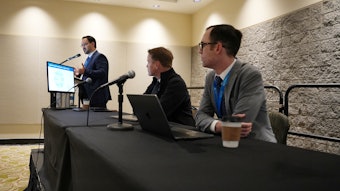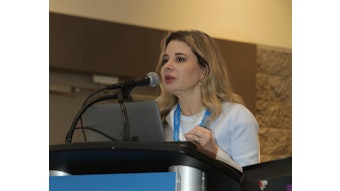New drugs mean new reactions
Knowledge of the side effects of new medications is a critical aspect of dermatologic care.

Adverse drug reactions are an inevitable part of any medical profession, and dermatology is no exception. Cutaneous eruptions are among the most common responses, especially with some of the newer drugs.
These eruptions — and how to treat them — were the focus of Friday’s session, F021 – New Drugs, New Rashes: An Update on Cutaneous Drug Eruptions, led by Susan Burgin, MD, FAAD, associate professor of dermatology at Brigham and Women’s Hospital in Boston.
Cancer
New and emerging treatments for cancer — including chemotherapies, targeted therapies, and immunotherapy — can often produce cutaneous side effects such as rashes. Connie Shi, MD, FAAD, said one such drug is amivantamab, a monoclonal antibody targeting epidermal growth factor receptor (EGFR) and mesenchymal–epithelial transition factor (MET) that is currently used in the treatment of non-small cell lung cancer.
“EGFR inhibitors have been in use for decades and are known to be associated with acneiform rash, paronychia and nail toxicities, xerosis, and oral mucositis, among others. But amivantamab appears to have a higher prevalence of scalp toxicities, including scalp folliculitis and erosive pustular dermatosis,” said Dr. Shi, an oncodermatologist at Brigham and Women’s Hospital/Dana Farber Cancer Institute and instructor in dermatology at Harvard Medical School.
Dr. Shi said these scalp toxicities can be severe, pose significant challenges to the patient’s quality of life, and limit their ability to continue therapy. For these reasons, it’s important for dermatologists to know what to do when they encounter these adverse events.
“The rapid pace of innovation and change in the oncologic therapy space and the expanding indications for various chemotherapy, targeted therapy, and immunotherapy agents means that dermatologists will increasingly encounter cutaneous side effects of these treatments among our patients,” she said.
Another cancer treatment that can produce cutaneous side effects is immune checkpoint inhibitors (ICI). Jennifer Choi, MD, FAAD, professor of dermatology and chief of the divisions of oncodermatology and medical dermatology at Northwestern University Feinberg School of Medicine in Chicago, said these drugs are classified into three main categories: PD-1 inhibitors (e.g., pembrolizumab, nivolumab); PD-L1 inhibitors (e.g., atezolizumab, durvalumab); and CTLA-4 inhibitors (e.g., ipilimumab).
“These work by blocking specific immune checkpoints to enhance T-cell activity, which can trigger autoimmune-like skin reactions,” she said. “This can include a wide range of cutaneous side effects, such as maculopapular rash, pruritus, lichenoid dermatitis, psoriasisiform eruptions, bullous pemphigoid-like reactions, erythema multiforme, or Steven-Johnson-like syndrome.”
Dr. Choi said the treatments can also produce rarer adverse events, including alopecia areata, and while most of the effects are mild-to-moderate, some may require the discontinuation of the therapy along with systemic immunosuppression.
“It is crucial for dermatologists to be aware of these drugs and their side effects because dermatologists play a key role in recognizing and managing these immune-related skin toxicities,” she said. “Early identification can prevent severe complications and help oncologists identify whether the specific cutaneous side effect is life-threatening or not and determine if the immunotherapy must be stopped or can be continued.”
Treatment strategies for these conditions can vary from topical treatments to systemic medications, depending on the severity. Dr. Choi said she prefers using steroid-sparing agents for difficult or persistent reactions, which can help prevent systemic immunosuppression in cancer patients.
Biologics
Biologic therapies are becoming more common in dermatologic settings, especially for treating psoriasis and atopic dermatitis. Jeffrey Cohen, MD, FAAD, director of the Psoriasis Treatment Program and assistant professor of dermatology at Yale University School of Medicine, said the paradoxical eruptions associated with these therapies, while relatively uncommon, can be a challenge to recognize and treat.
Dr. Cohen said paradoxical reactions occur when a treatment that is effective ends up generating a response that is the opposite of what is intended. These often have a classic appearance similar to other conditions, making them difficult to recognize.
“Biologics have revolutionized the treatment of inflammatory skin diseases like psoriasis and eczema,” he said. “It’s important for dermatologists to feel comfortable using these medications and managing any side effects that may occur. Therefore, it is essential for dermatologists to be able to adequately recognize and adequately manage paradoxical eruptions in patients on biologics.”
TEN-like conditions
Toxic epidermal necrolysis (TEN) is a severe, life-threatening medication reaction. Drug-induced TEN-like conditions are a group of rare reactions that mimic TEN.
Dr. Burgin discussed some of those conditions, including TEN-like acute generalized exanthematous pustulosis (AGEP) and methotrexate-induced epidermal necrosis.
“Severe toxic erythema of chemotherapy may resemble TEN and while the immune checkpoint inhibitors have been reported to cause true Stevens-Johnson syndrome/TEN, a TEN-like condition known as progressive immunotherapy-related mucocutaneous eruption (PIRME) has also been reported,” she said.
Even though these conditions are rare, Dr. Burgin said dermatologists should be able to differentiate between them and true TEN.
“As we know, TEN is a true dermatologic emergency and it may be life-threatening,” she said. “Knowledge of the differential diagnosis and the side-effect profiles of newer drugs are vital when assessing such a patient. TEN-like conditions themselves are also frequently severe and they require active therapeutic intervention and often admission for optimal care.”
Helena Pasieka, MD, FAAD, also gave updates on TEN in her presentation on severe cutaneous adverse reactions (SCAR).











